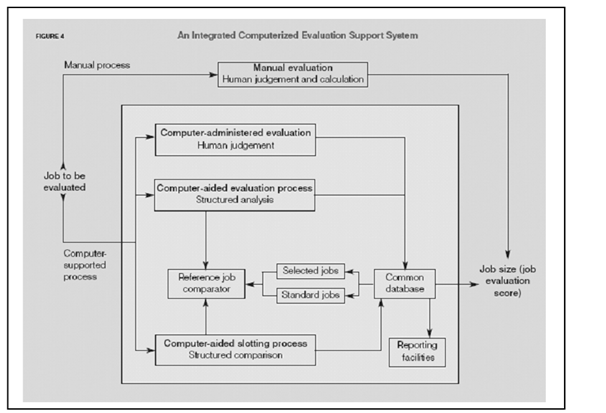COMPUTERISED JOB EVALUATION
The computerization of job evaluation is growing into an effective way of supporting the purpose of global organizations, highly due to the potential of network based job evaluation tools. They fall into two wide areas:
1) Administrative support, and
2) Evaluation decision support.
Administrative support is regarding managing the data having the usual array of reporting facilities. Evaluation decision support gives guidance to the evaluator in many degrees with the aim of developing objectivity and consistency. Frequently built approximately a questionnaire that aids the analysis of a job utilizing cross-comparisons and 'sense-checks', computerization supports a slotting procedure, efficiency, improving speed & the recording of 'evidence'. More sophisticated questionnaire schema emulates the evaluation procedure through intelligent 'rules' that produce computer decision. By definition, the 'rules' are, more precise, provide a consistent result for a given set of inputs and may calculate a range of job content features much faster.
Now there is more choice than ever in implementing job evaluation, as described:
1) Manual systems,
2) Systems supported by stand-alone computers,
3) Local networked systems on a common limited database,
4) Intranet/Internet-based systems that permit apparent control from a central point but let significant involvement, and
5) Intranet/Internet-based systems that allow job evaluation decisions to be devolved to line management.
Smaller organizations are probable to keep manual systems (by including some spreadsheet tools) but might adopt more sophisticated computerized methods when keeping close central control. Big organizations are likely to desire to spread the management task beyond the centre and will desire to consider how the job evaluation procedure integrates along the mainstream HR information systems. Obviously, it is wanted highly to have common platforms, though the nature of job evaluation does not need a 'real-time' system.
An inclusive system that incorporates a variety of job tools and procedure - from a manual scheme to a computerized questionnaire & slotting procedure is illustrated below in given figure. Supposing a single analytical job evaluation method, a specific job can be evaluated by using a number of probable paths to arrive at a job evaluation score which is universally compatible with any of the procedure. Given figure shows a manual procedure and a computerized administration option. Additionally, it shows that a computerized analysis by using a questionnaire may be employed to generate a job evaluation score and to enable simple comparison along a set of reference jobs. These first two computer-supported procedures are analytical job evaluation methods. At last, a rapid slotting procedure might be utilized to cross-compare having the set of reference jobs and, as a consequence of the linkage to one of these, recommend a job evaluation score. The ordinary database of evaluation scores let the management of comparisons to a set of reference jobs, which might be a combination of specifically focused jobs or standard (generic) jobs. Reporting facilities will enable manufacture of detailed standard and user-designed reports.
Figure 1
